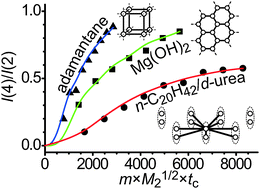A statistical approach for analyzing the development of 1H multiple-quantum coherence in solids†
Abstract
A novel statistical approach for analyzing 1H multiple-quantum (MQ) spin dynamics in so-called spin-counting

* Corresponding authors
a
Division of Chemistry, Graduate School of Science, Kyoto University, Kyoto 606-8502, Japan
E-mail:
takeyan@kuchem.kyoto-u.ac.jp
Fax: +81 75-753-4011
Tel: +81 75-753-4015
A novel statistical approach for analyzing 1H multiple-quantum (MQ) spin dynamics in so-called spin-counting

 Please wait while we load your content...
Something went wrong. Try again?
Please wait while we load your content...
Something went wrong. Try again?
Y. Mogami, Y. Noda, H. Ishikawa and K. Takegoshi, Phys. Chem. Chem. Phys., 2013, 15, 7403 DOI: 10.1039/C3CP43778G
To request permission to reproduce material from this article, please go to the Copyright Clearance Center request page.
If you are an author contributing to an RSC publication, you do not need to request permission provided correct acknowledgement is given.
If you are the author of this article, you do not need to request permission to reproduce figures and diagrams provided correct acknowledgement is given. If you want to reproduce the whole article in a third-party publication (excluding your thesis/dissertation for which permission is not required) please go to the Copyright Clearance Center request page.
Read more about how to correctly acknowledge RSC content.
 Fetching data from CrossRef.
Fetching data from CrossRef.
This may take some time to load.
Loading related content
